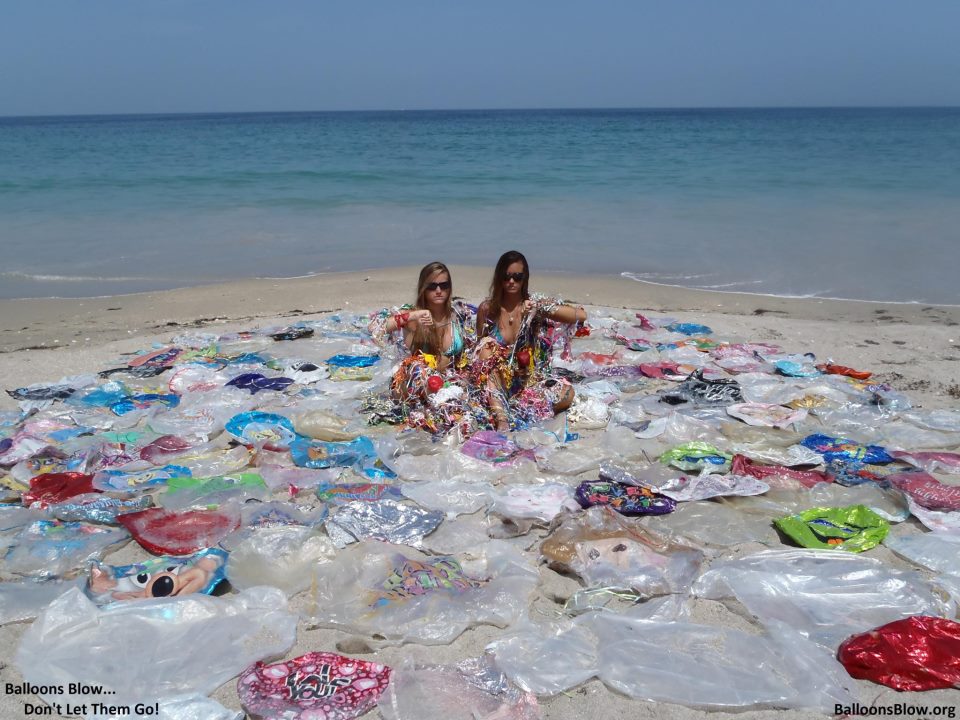The balloon industry has set “standards” for themselves claiming that releasing balloons that are hand-tied, so-called, “biodegradable” latex balloons without any attachments of ribbon is environmentally friendly. The balloons pictured below were released to their standards. Some are months old, some are years old. Natural latex may be biodegradable, but after adding chemicals, plasticizers and artificial dyes, how natural could it be? In fact to make latex suitable for balloon production, curing agents, accelarators, oil, color and water must be added. It may degrade after several years, but it’s surely not “biodegradable.”
 Balloon enthusiasts claim that when a balloon pops, it bursts into many little pieces, and that the pieces land far away from each other. Another claim is that so-called “biodegradable” latex balloons take the same amount of time to decompose as an oak leaf does. This is very misleading; oak leaves are very durable and can take four years to decompose! That means the balloons have plenty of time to injure or kill. Many animals mistake burst so-called “biodegradable” latex balloons as food, causing intestinal blockage and death. The ribbons or string that is sometimes tied to balloons, whether it is “biodegradable” or not, will last years and can also entangle any animal that comes in contact with it. See Impacts on Wildlife & the Environment.
Balloon enthusiasts claim that when a balloon pops, it bursts into many little pieces, and that the pieces land far away from each other. Another claim is that so-called “biodegradable” latex balloons take the same amount of time to decompose as an oak leaf does. This is very misleading; oak leaves are very durable and can take four years to decompose! That means the balloons have plenty of time to injure or kill. Many animals mistake burst so-called “biodegradable” latex balloons as food, causing intestinal blockage and death. The ribbons or string that is sometimes tied to balloons, whether it is “biodegradable” or not, will last years and can also entangle any animal that comes in contact with it. See Impacts on Wildlife & the Environment.
Most balloon enthusiasts are in the balloon business. They profit from the sale of balloons. They encourage people to disregard everything scientists, wildlife rehabilitators and conservationists are reporting about the impacts balloons have on animals and the environment so they can continue to profit from balloon releases. There are other ways to sell balloons than to encourage balloon releases, but mass balloon releases bring in big profits.
We find many more of these so-called “biodegradable” latex balloons, perhaps because the balloon industry has promoted this false information. Some understand that mylar (plastic foil) balloons are harmful to the environment, but are led to believe that latex balloons are environmentally friendly. The above picture proves they are not, also see photo gallery.
Other balloon enthusiasts are often ordinary people that have been releasing balloons for years for a certain purpose. These people may feel attacked when a concerned fellow human explains the impacts of balloons, but that does not mean they can ignore the facts. It is hard to hear that you were wrong for doing something you believed was acceptable, but after seeing the photos and reading the facts, it is easy to change your ways. See The Ugly Truth.
Balloon pollution is a growing problem and one that needs to be addressed. We need to inform people about this growing problem and stop it before the damage continues. Nobody wants to be a litterbug and releasing balloons is simply littering.
The pictures are proof; just take a look through the photo gallery. This is the non-biased truth, straight from the natural world. Each balloon is photographed exactly as it is found for documentation of its condition and location, before it is collected. Many people from around the world are also adding photos of balloons they have found invading their favorite places. From oceans to lakesides, from deserts to forests; balloons are being found in the most pristine and wild habitats.
Please do not take what you hear or read from balloon enthusiasts to be fact. When they tell you it biodegrades, remember they may breakdown eventually after many years, but they do not truly “biodegrade.” When they tell you they pop into little pieces, look at the pictures. When they say that it does not impact wildlife, the pictures show the truth that it can kill and injure many different species on land and sea.
The additional fact that we here at Ocean Crusaders don’t like is that Helium is not an infinite resource and is required for the medical industry, much more than for a few balloons. In our opinion, there is no such thing as a good balloon release.
By informing other people, you can help save wildlife. Please inform every one you can of this issue.
http://balloonsblow.org/ provided a lot of this artile. We have added to their article with a few additional facts.


